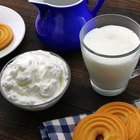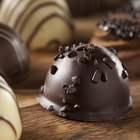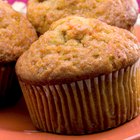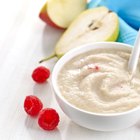AnnaPustynnikova/iStock/GettyImages
First of all, what is light cream? It's a term unfamiliar to many Americans, though it's common in Europe, where it's often used in coffee and tea and for making sauces and gravies. But it makes sense; after all, we have heavy cream, right? Light cream is basically just whole milk with some cream added in, typically having between 18 and 30 percent butterfat. And when trying to select a light cream substitute, the best way is to go by the butterfat content.
Half-and-Half Substitute
In most recipes, you can substitute half-and-half for light cream. Half-and-half has less butterfat – only between 10.5 and 18 percent – so sauces and gravies will be a bit lighter; but if it's used in baking or as a casserole or side dish ingredient, the difference is negligible. Make your own half-and-half by combining equal parts of whole milk and heavy or whipping cream that has butterfat content between 30 and 36 percent.
Evaporated Milk Alternate
Evaporated milk is sold in cans. It's whole milk that has half its water content removed. When mixed with equal parts water, it replaces whole milk in recipes. Regular evaporated milk is a good alternate for light cream, too. However, since it has only 8 percent butterfat, it won't thicken as well as light cream. To compensate, blend a little flour or cornstarch into evaporated milk to increase its thickening power before adding it to other ingredients.
Whole Milk Replacement
If all you have on hand is whole milk, you can increase its butterfat content and use it in place of light cream. Add 3 tablespoons of butter to 7/8 cup of whole milk to replicate 1 cup of light cream.
Cottage Cheese-Milk Stand-In
For each cup of light cream called for, blend or process 1/2 cup each of whole milk and cottage cheese. The butterfat in the cottage cheese replaces the butter added to the whole milk substitute.
Cream Cooking Tips
Whatever type of cream or cream substitute you use, always heat it over very low heat, and don't leave it unattended, as it scorches quickly and easily, giving the recipe a burnt, off-putting taste. To avoid this mistake, always heat cream in a double boiler over water that is just below simmering. Don't let cream-based sauces come to a boil, as this encourages breaking, which makes the sauce lumpy and unattractive.
If you'd like to turn the tables and use light cream as a substitute for other dairy ingredients, that's a possibility as well. For example, it can stand in for milk or half-and-half when fat content isn't essential (as in baking). You can also replace 1 cup of heavy cream with 3/4 cup of light cream and 1/3 cup butter. Note that light cream doesn't whip, though, so it can't stand in for heavy whipping cream.
Related Articles

Substitute for Light Cream in Cooking

Different Types of Whipping Cream

How to Bring Cream to a Boil

Heavy Cream vs. Milk in Baking

Does Cream Spoil?

What Else Could You Use Besides Cream ...

Calories in a Tablespoon of Cream Cheese

Can You Water Down Heavy Cream to Make ...

How to Substitute Cream for Buttermilk
The Difference Between ...

How to Make Scalded Cream

Why Does Some Alcohol Curdle Cream?

What Happens if I Forget to Refrigerate ...

What Can Be Used as a Substitute for ...

Calories in Dark Chocolate Truffles

Heavy Whipping Cream Vs. Half & Half

Substitute for Manioc Starch

How Many Calories Are in Cream of Wheat?

Substitutes for Clotted Cream
Cream vs. Creamer
References
Writer Bio
Cassie Damewood has been a writer and editor since 1985. She writes about food and cooking for various websites, including My Great Recipes, and serves as the copy editor for "Food Loves Beer" magazine. Damewood completed a Bachelor of Arts in English with an emphasis in creative writing at Miami University.